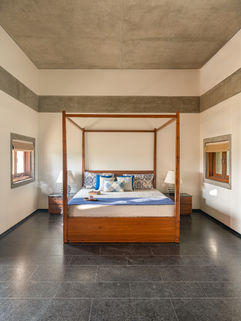HOUSE OF SEVEN COURTS,
AHMEDABAD, 2019
Located on the outskirts of Mehsana, this farmhouse was built for the clients who had just one requirement - a three-bedroom house. As architects, we were given complete freedom to explore various materials, colours, and building techniques. The house was designed based on the principles of passive design. Responding to the hot and dry climate of this region, the spaces are oriented along the North-South axis with parallel solid walls along the East and West to reduce solar heat gain. This climatic orientation led to the rise of seven courtyards inside the house, three in the public areas like living and dining, and four private courts attached to the bedrooms and bathrooms. A deep south-west facing verandah is provided to avoid any direct solar gain during summer ensuring the penetration of the early winter sun inside the main spaces.
The house is a single-storeyed structure with a living- dining space, kitchen, and three bedrooms. From the approach road, one walks along a linear wall with circular cut-outs that create interesting patterns. At the entry of the house, one is welcomed in the courtyard with a lily pond. There is another courtyard at the junction of these public and private spaces. The entrances of the bedrooms are flanked by a linear court along with private courts for each bedroom. In the NE corner are the servant quarters directly connected to the utility kitchen. The central spine is an essential circulation space of the house. It begins linearly at the arrival court and is twisted at the main entrance of the house. It then moves along the functional spaces, cranks, and leads to the bedrooms. The change of direction notifies the user that they are heading to a more private zone. One can see an interesting pattern of light and shadows throughout their journey along this central spine. All these built spaces are connected to the outer verandah establishing a horizontal connection with the landscaped garden in the front.
As a passive design strategy, the habitable rooms were given a greater height than the circulation spaces and the verandahs. The beams of the verandahs were continued in the rooms, and a non- structural wall was constructed above it that supports the ventilators. The windows allow the summer breeze to come in, whereas these ventilators help flush out the hot air, keeping the space much cooler.
Photographer: Vinay Panjwani



















